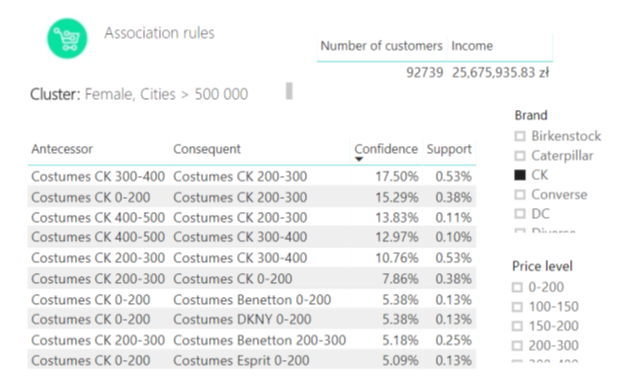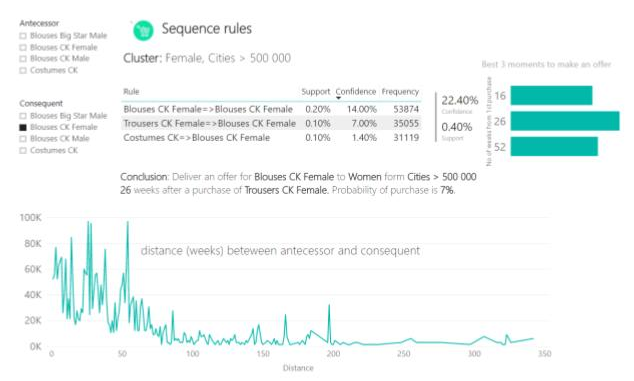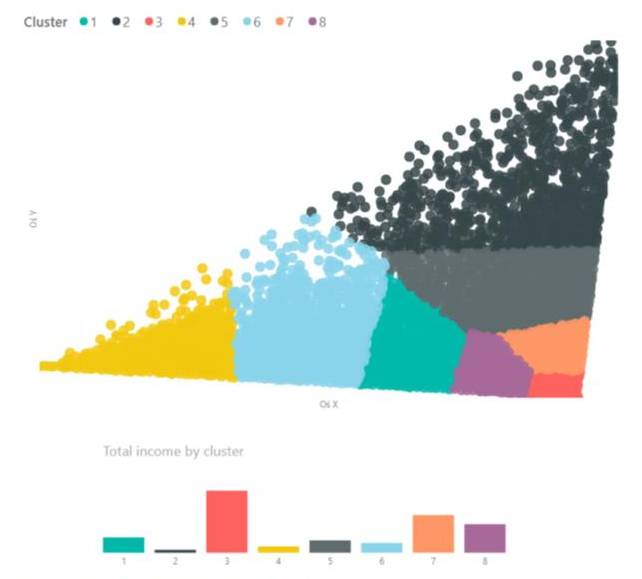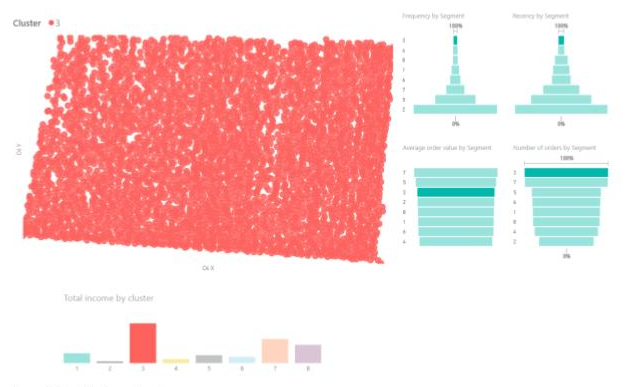
Customer Intelligence
Change the course of your e-commerce - set sails towards real profits and profound knowledge of your clients thanks to machine learning & customer intelligence.



Change the course of your e-commerce - set sails towards real profits and profound knowledge of your clients thanks to machine learning & customer intelligence.


Currently, companies operating in retail must face a very competitive market. They very often set their goal at gaining a high number of new customers to surpass their competition. Therefore, they run very intense marketing activities in various channels and attract potential customers mainly with price reductions. Such aggressive policy affects the profitability and as result can lead to situation where some activities end up with unsatisfactory financial results (we sell with too little margin). It happens very often that customers are discouraged by receiving another mismatched e-mail about a new promotion or even after the purchase they see the banners of purchased product on every website due to a retargeting campaign.
It is important to realize that, especially when operating in the e-Commerce model, we gather a lot of data about our current customers. We know almost everything about the transactions they have made and much about their demographic profile. We have access to applications and systems that allow us to conduct targeted marketing campaigns, for example: Facebook, marketing automation tools, remarketing systems or recommendation tools. In addition, when it comes to analyzing the traffic and sales of our online store, we have reports offered by Google Analytics or other competitive solutions. The marketing automation tools allow you to provide any marketing message to any group of clients. Reality, however, shows that the majority of online campaigns are built based on the intuition of a marketing specialist and in many cases we do not notice the conclusions resulting from methodical data analysis. As a result of such approach, companies send huge amounts of emails, which are immediately deleted by recipients before reading.
The e-commerce and offline retail markets are currently saturated and as a result highly competitive. We have a number of suppliers with a broad range of various products to satisfy customer needs such as conducting campaigns using the modern and effective tools mentioned above or creating a sales strategy based on conclusions from expert opinions provided by external market research agencies. But each of our competitors has the same access to knowledge that we can acquire. So where do we find our competitive advantage? In order to surpass our competitors, we need to learn and understand the motivations of customers to make a purchase. Having such awareness, we can communicate with them in a way that is tailored for every single customer
While the tools mentioned above can be effective, most of them are fundamentally limited due to lacking a holistic view of the data. For example, they collect data from a certain point in time preventing data analysis basing on a history. Others present only aggregated data about traffic (with no detailed information regarding who viewed which product or who ordered what as a result of certain campaign. Such approach makes it very difficult to generate, for example, a list of customers who bought a product on the last sale and haven’t visited us since.
If we collect data from various sources such as transactions history, we can generate a number of advanced analyzes that would provide new and non-trivial knowledge about the company itself, its customers or products. Such knowledge enables setting well thought-out sales targets correlated with the company's strategic goals. Such provided business conclusions will help us in the application of activities that would make the goals achievable.
Much is currently being said about the Big Data approach, which tries to make us believe that its technology is a "magic" black box to which we can upload any amount of data in any formats and it will output automatically a solution ready to be applied for our problems and business challenges. The reality is different. As with any IT system implementation, we need to define clear goals here and design the system to fulfill these goals.
The most popular and the most commonly used methods of machine learning in sales and marketing are:
Classification and prediction, in a nutshell, is where we set an indicator referred to as target variable and we build a model that is able to estimate the value of such target for our business cases. For example, we may consider why customers return purchased products, why customers decide to buy a product, to participate in a sale or resign from our services. If we knew the answers to these questions, we could undertake specific actions to minimize negative events (returns, churn) or increase the effects of positive events (purchase, purchase of an additional product, extension of the subscription, participation in the sale). Here we have a group of algorithms that build predictive models that we train basing on historical data. Therefore, we provide the algorithm with the information who and under what circumstances took part in previous sales. We treat customers as a series of variables describing their demographic profile (eg gender, place of residence), history of transactions (eg how many purchases they made, what they bought or how they reacted on discount), preferences (what assortment they bought, which brands they selected and many others). On such basis the algorithm looks for the relationship between the customer's description and a behavior defined by us as a target. These relationships are called the predictive model and this model can be executed in the context of a new client to estimate the probability of the analyzed event occurrence.
If we execute such a model on the entire database of our customers - then we can estimate for each of them individually whether they would buy a product on sale, whether they would resign our subscription services, report a complaint, etc. So if we have a list of customers who are likely to leave us - it's worth contacting them and suggesting, for example, some additional value that would encourage them to stay. For customers who are likely to buy on a sale, maybe we shouldn’t perform any specific and expensive marketing activities, but for those who hesitate (for example, the probability is between 15% and 50%) we can try to reach via a relatively expensive but effective channel - e.g. on youtube, paper letter, etc.
Our experience shows that we can relatively precisely identify a group of customers who hesitate. The campaigns carried out with the support of prediction model have given us a 15 percent conversion, which fully justifies the use of a relatively expensive way of reaching the client
Another method of extracting business hypotheses is to search for patterns in the data. An example is the mechanism of association rules, sequences or so-called Collaborative filtering.
The mechanism of association rules is very often referred to as the analysis of a shopping basket. We indicate here which products are likely bought together and with which probability. On this basis, we can build a mechanism for intelligent product recommendations.

To generate associations, we assign products to segments, taking into account, for example, the product category (eg Shoes, T-shirts, Costumes), who they are directed for (male, female, children's,), price level (eg up to 100, 100-300, above 300), brand, color, discount level and many more.
An example (based on fictitious data) shows the probability of consequentially buying a product in the event of choosing an antecessor product. The rules apply to the segment of women living in big cities.
An example rule states that if a woman from a big city buys an expensive CK costume, she also purchases a slightly cheaper one of the same brand with 17.5% probability.
Generation of such rules enables:
The mechanism of sequential rules showing the order of purchases made by customers and the distance between purchases.

The example shows that the probability of buying a female blouse of the selected brand after the purchase of female trousers is 7%. There is also presented the time distribution after which the customer makes the next purchase - in our case the local maxima occurs in weeks 16, 26, 52 after the first purchase. Observing such fact, we know at what moment to recommend a purchase to the client, so that it would be the most probable.
It is worth emphasizing that machine learning systems will automatically prepare hundreds of hypotheses as well as validate them. When planning a campaign with such approach, we do not have to wonder whether people buying summer baby shoes should be proposed to buy also winter shoes in October. The mechanism automatically generates rules and performs automatic evaluation to suggest optimal actions in reference to each segment of clients or even each individual customer.
An interesting group of algorithms are also referred to as clustering algorithms, which analyze variables describing selected objects and connect similar objects into one cluster. If we group, for example, customers described with data about their transactions, then the system will help us to assign clients to particular profiles, assess individual segments and interpret the characteristics of these segments. The segmentation example shown in Figure 3 was inspired by the RFM (Recency, frequency, money) method. For the customer's description we took the frequency of purchases made by customers, the average value of the order, and the number of days since the last order. In addition to the customer description, the number of orders has been added. The customers were divided into 8 segments and for each the value was calculated (the sum of all customer orders from the segment and the value of the margin on those clients)

The figure 3 shows that the highest income is generated by segment No. 3 (red one). If we are tempted to interpret this segment, we can see in Figure 4 that it is a segment of clients who make a purchase very often, have made the last purchase recently and their number of orders is the highest in all segments. What is interesting are the customer segments in which the average order value is higher. It can therefore be said that these are the most loyal customers, though not the ones who buy the most expensive items.

A more detailed analysis of each segment will allow us to define, for example, a promotional policy, communication policy, etc. On this basis, we determine what customers can be given bonuses and which channels to use in communication with them as well as how often and at what product price level to offer them.
We have also conducted customer segmentation experiments based on attributes describing customers' motivation to purchase during sales and price reductions, where at the opposite site we have customers buying new products and fashionable items at catalog prices. Assigning customers to the relevant segments allows for precise profiling of marketing messages in the context of informing about new and expensive products or sales and promotions.
Segmentation mechanisms can be used not only for analyzing customers. We can cluster our products, transactions and in the next step connect segments of customers, transactions made by them and purchased products to answer the questions who is buying what, when and under what conditions.
It transpires from our research that the combination of different methods of advanced data analysis gives the best results. The full process requires from us:
In our opinion, the way to achieve competitive advantage in a currently competitive market, leads through the integration of data from various channels of contact with the customer and conducting advanced analyzes to understand the motivations and needs of customers. The conclusions from these analyzes should be applied in the creation of marketing and sales policies. Due to the large amount of data describing the entire scope of cooperation with the customer, Big Data technologies and techniques can help us here. Mechanisms of machine learning and artificial intelligence will allow for the partial or fully automatic detection of certain patterns, which in case of classical analyzes are not easily available. Having those patterns generated we may use the acquired knowledge in contact with the client to increase profitability of our business.